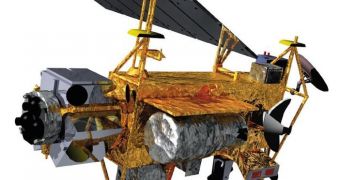Even though it was tracked from multiple points on the Earth's surface, the exact region where the remains of the destroyed UARS satellites fell to the ground is not yet known. In all likelihood, it could remain that way for a very long time, experts say.
The Upper Atmosphere Research Satellite spent 20 years in Earth's orbit before dropping through the atmosphere on Friday, between 11:23 pm EDT Friday and 1:09 am EDT, September 24 (0323 and 0509 GMT, Saturday).
According to the American space agency, the spacecraft completed a successful, 14-year mission, during which time it contributed extensively to forwarding our knowledge about the atmosphere and the phenomena going on high above the surface of the planet.
In fact, the UARS is to thank for some of the first long-term readings detailing the chemical composition and evolution of the atmosphere. However, when the time came for decommissioning, the path the satellite should have taken became a thing of the past.
The satellite reentered Earth's upper atmosphere at an uncontrolled angle and velocity, and finally impacted the ground or the ocean a couple of days ago. Scientists now say that it's very likely its exact location will never be uncovered.
Experts said before the crash occurred that there is a high chance no more than 26 pieces of the satellite will survive reentry. These components are made out of materials such as titanium and beryllium, which cannot be destroyed by the high temperatures friction generates during atmospheric reentry.
As it was descending through the air, UARS moved from eastern Africa to the Indian Ocean, and then veered towards the Pacific Ocean and northern Canada. Next, it moved over the northern Atlantic ocean and into west Africa.
As such, most of its trek took it above water, rather than dry land. Some regions in Canada and Africa are the only places on the planet where experts could expect to find at least some remnants of the destroyed satellite, Space reports.
The most precise estimates available at this point indicate that UARS disintegrated above the Pacific Ocean, a long distance off United States coastlines. Thus far, NASA received no reports of injury or property damage.
“We extend our appreciation to the Joint Space Operations Center for monitoring UARS not only this past week but also throughout its entire 20 years on orbit,” NASA orbital debris chief scientist Nick Johnson explains. He is based at the agency's Johnson Space Center (JSC), in Houston, Texas.
“This was not an easy re-entry to predict because of the natural forces acting on the satellite as its orbit decayed. Space-faring nations around the world also were monitoring the satellite’s descent in the last two hours and all the predictions were well within the range estimated by JspOC,” he adds.

 14 DAY TRIAL //
14 DAY TRIAL //